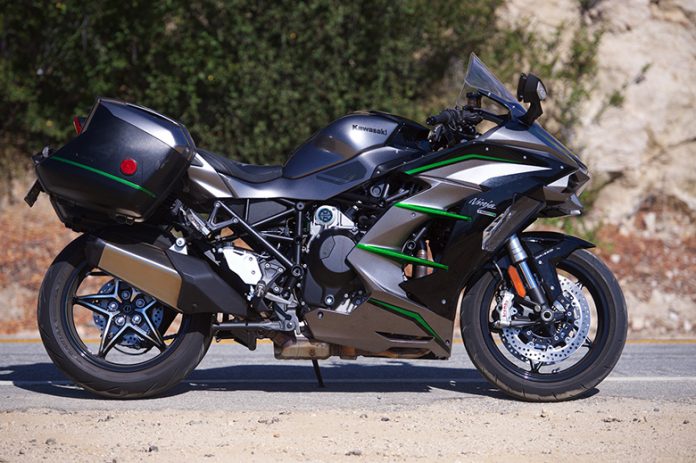Activate your journey with the new 2020 Kawasaki Ninja H2 SX SE Sports Bike as it provides the intense sensory experience of a supercharged engine for sports tours, the third edition of Kawasaki’s unique supercharged family. The balanced supercharged engine is designed for everyday road riding scenarios and offers high fuel economy.
The Kawasaki Ninja H2TM SX SE + motorcycle is the most advanced Ninja H2, featuring Kawasaki Electronic Control Suspension (KECS), smartphone connectivity, and integrated riding modes. It will impress those who value advanced equipment and the passion for supercharged acceleration.
2020 Kawasaki Ninja H2 SX SE Sports Bike – Features and Specs
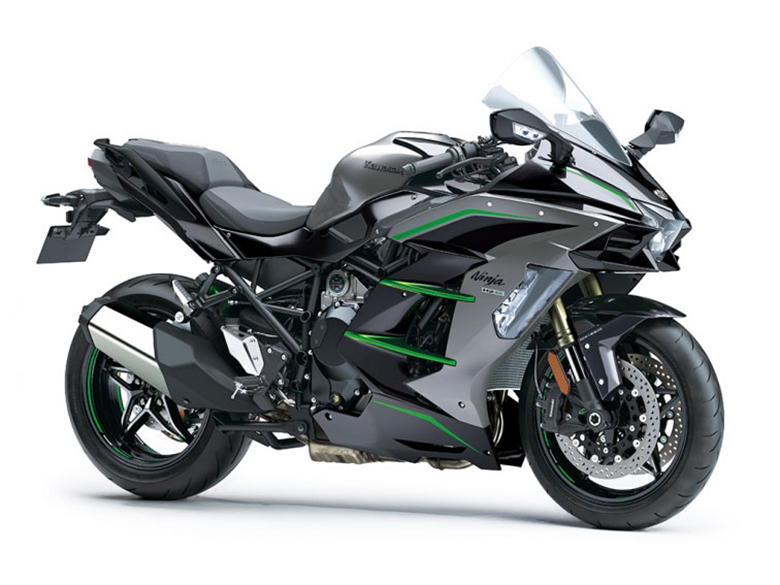
Engine
While the basic design is based on the Ninja H2TM motorbike’s supercharged engine, the Ninja H2TM SX SE + is a type of engine that has undergone numerous modifications to achieve the desired power and fuel efficiency balance for the motorcycle. The balanced supercharged engine delivers astonishing speeds as well as exceptional fuel efficiency.
Supercharged Intake
The centrifugal-type supercharger invented and manufactured by Kawasaki has great pumping capacity. The crankshaft drives a planetary gear, which rotates a 69 mm impeller uniquely crafted using Kawasaki gas turbines and aerospace expertise. Because the supercharger is so efficient, the compressed intake air is heated a bit, so no intercooler is needed.
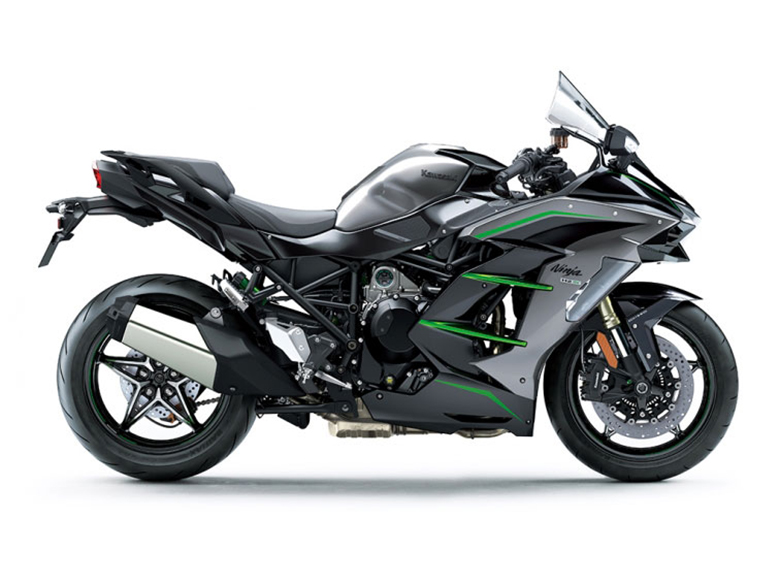
To help maximize power, the Ram Air Intake Duct sends fresh air to the supercharger as far as possible in a straight line between the supercharger and the throttle bodies, and an aluminum intake chamber helps dissipate heat and keep the air cool. When the throttle stops, the ECU-controlled blow-off valve limits the pressure increase in the intake chamber, which prevents the impeller from overheating and excessive vibration.
The front of the ram is on the left. The use of air is according to the airflow requirements of a balanced supercharged engine. The intake duct provides fresh air directly to the supercharger to help the supercharger operate efficiently. The 69mm supercharger impeller Ninja H2 SX SE + was designed to improve the shape and angle of the blades for the power characteristics of the motorcycle. RPM and airflow volume settings were also tuned for maximum performance.
The impeller features six blades at the tip that extends up to 12 edges at the base and is made of the forged aluminum block using a five-axis CNC machining machine to ensure optimal accuracy and durability. The airflow is directed through the ducts carved into the blade surfaces.
Thanks to Kawasaki gas turbines and aerospace technology, the crankshaft operates a planetary gear train that increases the speed of the impeller by 9.2 times the speed of the crankshaft between the supercharger and the throttle bodies; an aluminum intake chamber helps to dissipate heat and keep the air cool. The diffusers at the mouth of the chamber, as well as the optimized volume and diecast construction, contribute to the overall performance of the supercharger, engine performance, and fuel efficiency. The stainless steel mesh at the end of the diffuser helps smooth the airflow.
Intake funnel lengths that are optimized and irregular help increase the efficiency of short and medium ranges. The outer cylinder funnels are smaller than the center cylinder funnels.
When the throttle stops, the ECU-controlled blow-off valve limits the pressure increase in the intake chamber, which prevents the impeller from overheating and excessive vibration. Instantaneous valve response contributes to power sensation and throttle response by maintaining maximum boost pressure.
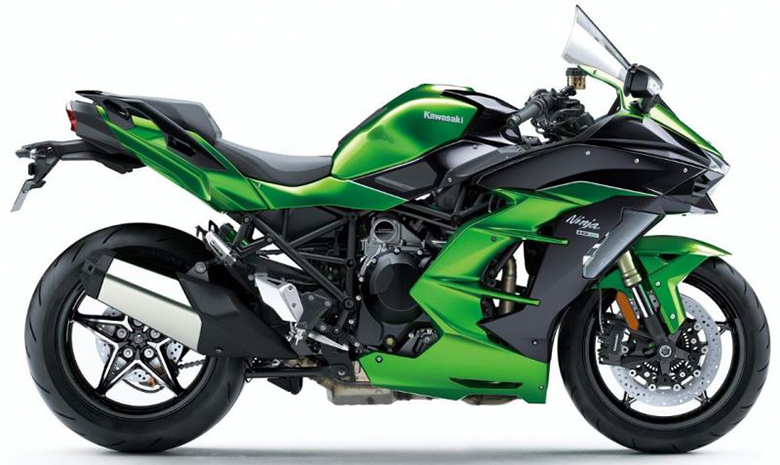
Using race technology developed for the Ninja® ZXTM-10R, a two-stage machining mechanism for the cylinder head creates the neck of the intake ports. The new valve seat area is bored twice: once for the throat and again for the valve seats. As a result, intake airflow is smoother, reducing intake loss and improving efficiency.
The cam profiles are designed to meet the airflow requirements of a typical road ride, resulting in lower to mid-range performance. Fuel savings intake and exhaust apertures are combined to improve low-mid-range performance and fuel efficiency. The rider can hear the supercharger’s trademark chirping through a sound hole in the intake duct.
Cruise Control
Electronic cruise control uses a button to maintain a certain speed, which can also be changed using the up/down toggles around you.
Transmission
The gears are connected to the input transmission shaft, and in the dog-ring transmission, the ring rotates to attach the bags to the output shaft, based on MotoGP technology. Mild shifts, better feel, and faster shifts are the result.
Transmission oil jets at each gear mesh and shift fork position provide direct cooling and better lubrication for excellent durability.
The primary gear ratio was chosen to improve fuel efficiency by reducing the demand for torque on transmission gears. In most normal riding conditions, the ratio of first to second gear also contributes to the engine’s handling.
Electronics
Due to Kawasaki’s next-level electronics and state-of-the-art programming that gives the ECU an accurate, real-time picture of what the chassis is doing with minimal software, Kawasaki’s state-of-the-art electronics are always on track. What is the best performance? The Ninja H2 SX SE + motorcycle’s electronic management technology has evolved from setting type and reaction type systems to feedback-type systems to the next level, thanks to the latest iteration of Bosch IMU and Kawasaki’s unique dynamic modeling software.
Inertial Measurement Unit (IMU)(KP)
IMU calculates inertia in five axes: longitude, transition, vertical speed, roll rate, and pitch rate. ECU calculates Yao rate with Kawasaki’s unique software to provide lean angle and acceleration/deletion force to the six-axis chassis for more accurate electronic riding aid management.
The IMU enables KTRC to add more feedback to help speed up exits at the turn on the race track.
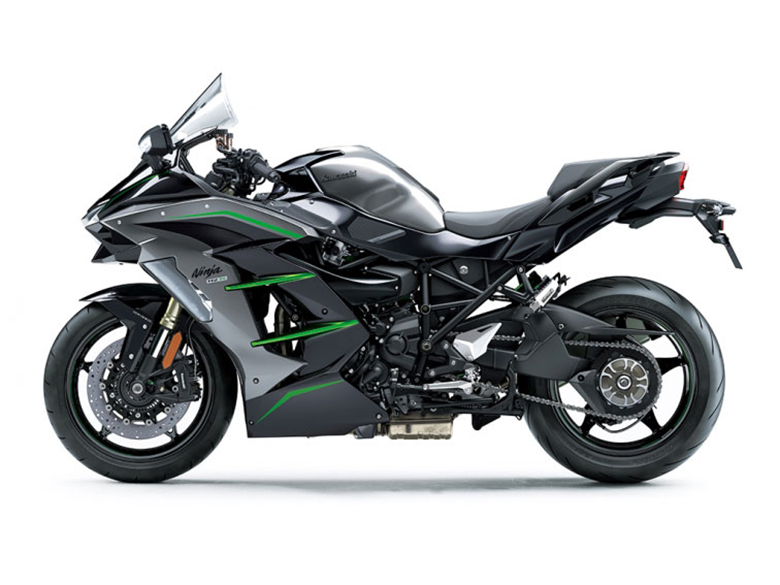
Unlike competing systems, which have defined boundaries, Kawasaki’s proprietary race-developed software allows the Ninja H2 SX SE + to offer a dynamic system that adapts to changing conditions such as rider input and vehicle. Attitude and response to floor conditions.
Chassis
Trails frame chassis
The Ninja H2 SX SE + motorbike has the same unique trail frame like the Ninja H2TM; the structure needs to be changed considerably to accommodate passengers and luggage. The longer wheelbase and increased rigidity improve highway stability, while a 30-degree steering angle improves handling at lower speeds.
The trail frame is made of high tensile steel, in which the diameter, thickness, and bend of each piece of pipe are precisely adjusted to achieve the desired stiffness. The engine is tilted two degrees to help reduce the center of gravity, which improves overall handling and highway stability.
Compared to the Ninja H2TM motorcycle, the sturdy, long rear frame increases the payload by more than 200 pounds – enough to support a two-up ride with luggage on the highway.
The diecast aluminum rear subframe’s slender frame design and horizontal attachment keep the seat tight and make it easy for the rider’s legs to reach the ground. BremboStylemamonoblock Callipers are lightweight and help cool the brake fluid for better performance. High-Performance Brakes, including Kawasaki Intelligent Anti-Lock Brake System (KIBS).
4-piston radial-mount brake caliper, radial-pump brake master cylinder, and large 320 mm brake discs provide excellent braking performance and feel. A dual-piston caliper clamps a 250mm disc in the rear brake.
To offer highly accurate brake pressure management, the engine ECU connects to a small ABS ECU (which observers wheel speed and front caliper hydraulic pressure). Due to the high accuracy control, excessive pressure dips do not impair the brake performance, and the lever sensation is more permanent than the sudden pulses experienced with conventional ABS systems.
Aggressive Styling
The front cowl ninja is inspired by the H2TM and features the Kawasaki Rivermark. Full firing protects the rider while not causing an excessive drag on the motorway speed. Large firing ducts help to display the supercharged engine while also removing heat from the compartment.
Even when the Ninja H2TM SX SE + is stopped, the oblique “high-voltage lines” at the front give the impression of traced speeds from side coils, wings, tail coils, and mufflers. All lights are LEDs, from recessed headlamps to slim taillights, which display a dual “H” at startup.
On either side of the firing are three fixed directional LED cornering lights. To project a wide beam of light in the direction in which the motorcycle is traveling, the lights are lit at a random angle. Excess air escapes from the rider’s upper torso with a large windscreen.
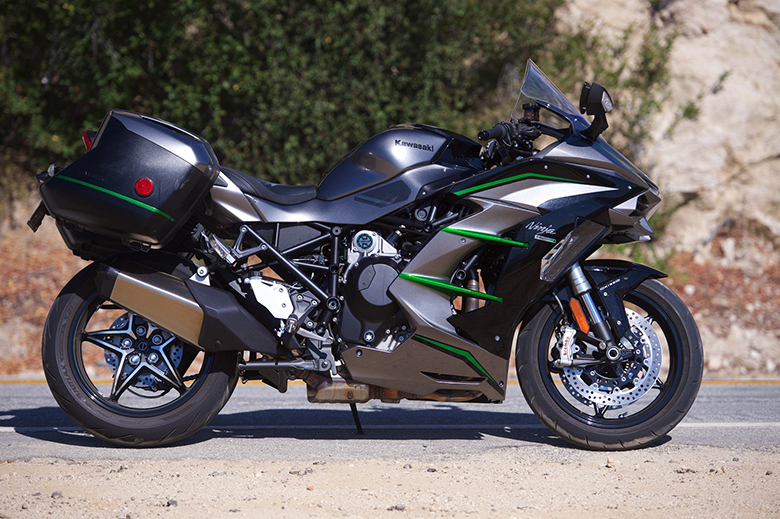
KIBS’s high-precision anti-lock brake system provides smooth feedback and minimal lever movement for added braking confidence.
2020 Kawasaki Ninja H2 SX SE Sports Bike – Technical Specifications
Engine
| Displacement | 998cc |
| Type | 4-stroke, In-Line Four |
| Bore and stroke | 76.0 x 55.0 mm |
| Cooling | Liquid |
| Compression ratio | 11.2:1 |
| Valve system | DOHC, 16 valves (4 valves-per-cylinder) |
| Fuel system | Fuel injection: 40mm x 4 having a dual injection |
| Ignition | Digital |
| Lubrication | Forced lubrication (wet sump) with oil cooler |
Brakes
| Front: type | Dual semi-floating 320 mm discs |
| Front: calipers | Dual radial-mount, monobloc, opposed 4-piston |
| Rear: type | Single 250 mm petal disc |
| Rear: calipers | 2-piston caliper |
Dimensions
| Overall length | 2,135 mm |
| Overall width | 775 mm |
| Overall height | 1,260 mm |
| Wheelbase | 1,480 mm |
| Ground clearance | 130 mm (5.1 in.) |
| Seat height | 835 mm |
| Curb mass | 260 kg |
| Fuel capacity | 19 liters (4.2 gals.) |
Drivetrain
| Transmission | 6-speed, return dog-ring |
| Final drive | Chain |
| Primary reduction ratio | 1.480 (74/50) |
| Gear ratio: 1st | 3.077 (40/13) |
| Gear ratio: 2nd | 2.471 (42/17) |
| Gear ratio: 3rd | 2.045 (45/22) |
| Gear ratio: 4th | 1.727 (38/22) |
| Gear ratio: 5th | 1.524 (32/21) |
| Gear ratio: 6th | 1.348 (31/23) |
| Final reduction ratio | 2.444 (44/18) |
| Clutch | Wet multi-disc, manual |
Frame
| Type | Trellis, high-tensile steel, with Swingarm Mounting Plate |
| Wheel travel: front | 120 mm (4.7 in.) |
| Tire: front | 120/70ZR17M/C (58W) |
| Wheel travel: rear | 139 mm |
| Tire: rear | 190/55ZR17M/C (75W) |
| Caster (rake) | 24.7° |
| Trail | 103 mm |
| Steering angle (left/right) | 30° / 30° |
Performance
| Maximum Power | 147 kW {200 PS} / 10,000 or 154 kW {210 PS} / 10,000 with RAM air |
| Maximum Torque | 137.0 N.m {14.0 kgf.m} / 9,500 |
Suspension
| Suspension, front | 43mm of inverted fork with rebound and compression damping and spring preload adjustability, and top-out springs |
| Suspension, rear | New Uni-Trak, gas-charged shock having piggyback reservoir, compression and rebound damping adjustability, remote spring preload adjuster, and top-out spring |
Details
| Warranty | 12 months warranty |

